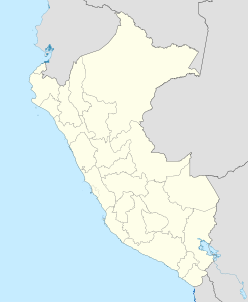| Carancas crater | |
|---|---|
Location in the Puno Region in Peru where the meteorite struck (16°39′52″S 69°02′38″W / 16.66444°S 69.04389°W).[1] | |
| Impact crater/structure | |
| Confidence | Confirmed |
| Diameter | 13.5 m (44 ft) |
| Depth | 4.5 metres (15 ft) |
| Age | 15 September 2007 |
| Exposed | Yes |
| Drilled | No |
| Bolide type | Chondrite |
| Location | |
| Location | Altiplano Basin |
| Coordinates | 16°39′51.98″S 69°02′38.99″W / 16.6644389°S 69.0441639°W |
| Country | Peru |
| State | Puno |
| Municipality | Carancas |
The Carancas impact event refers to the fall of the Carancas chondritic meteorite on September 15, 2007, near the village of Carancas in Peru, close to the Bolivian border and Lake Titicaca.[2][3][4][5] The impact created a small crater in the clay soil[6] and scorched earth around its location.[7] A local official, Marco Limache, said that "boiling water started coming out of the crater, and particles of rock and cinders were found nearby", as "fetid, noxious" gases spewed from the crater.[8][9] Surface impact occurred above 3,800 metres (12,500 ft).
After the impact, villagers who had approached the impact site grew sick from a then-unexplained illness, with a wide array of symptoms.[10][11][12] Two days later, Peruvian scientists confirmed that there had indeed been a meteorite strike, quieting widespread speculation that it might have been a geophysical rather than a celestial event. At that point, no further information on the cause of the mystery illness was known.[5] The ground water in the local area is known to contain arsenic compounds, and the illness is now believed to have been caused by arsenic poisoning incurred when residents of the area inhaled the vapor of the boiling arsenic-contaminated water.[13]
- ^ Cite error: The named reference
ingemmet1was invoked but never defined (see the help page). - ^ Planetario Max Schreier "Meteorito por el Desaguadreo" Archived September 19, 2007, at the Wayback Machine, September 24, 2007. Retrieved October 10, 2007.
- ^ RSOE Emergency and Disaster Information Service, Budapest, Hungary, "Cosmic Event - South-America"[permanent dead link], September 18, 2007. Retrieved October 10, 2007.
- ^ Teresa Cespedes, Reuters, "Peruvians get sick from apparent meteorite crater", September 18, 2007. Retrieved October 10, 2007.
- ^ a b Sutherland, Ed, ed. (20 September 2007). "Experts Confirm Peru Meteorite Site". All Headline News. Archived from the original on 20 October 2007. Retrieved 14 October 2024.
- ^ "Carancas". Earth Impact Database. Planetary and Space Science Centre University of New Brunswick Fredericton. Retrieved 2017-10-09.
- ^ Rory Carroll, The Guardian UK, "Peru meteorite crash 'causes mystery illness'", September 18, 2007. Retrieved October 10, 2007.
- ^ NBC News, "Villagers fall ill after fireball hits Peru", September 18, 2007. Retrieved October 10, 2007.
- ^ BBC News, "Scores ill in Peru 'meteor crash'", September 18, 2007. Retrieved October 10, 2007.
- ^ Lester Haines, The Register, "Peruvian 'meteorite' strike provokes noxious gas attack", September 18, 2007. Retrieved October 10, 2007.
- ^ Australian Broadcasting Corporation, "Locals fall sick after meteorite lands in Peru", September 18, 2007. Retrieved October 10, 2007.
- ^ Living in Peru, LIP-ir, "Doctors Aid in Rising Number of Illnesses after Meteorite Crash", September 19, 2007. Retrieved October 10, 2007.
- ^ Orozco, José (21 September 2007). "Meteor Crash in Peru Caused Mysterious Illness". National Geographic News. Archived from the original on 13 October 2007. Retrieved 14 October 2024.
